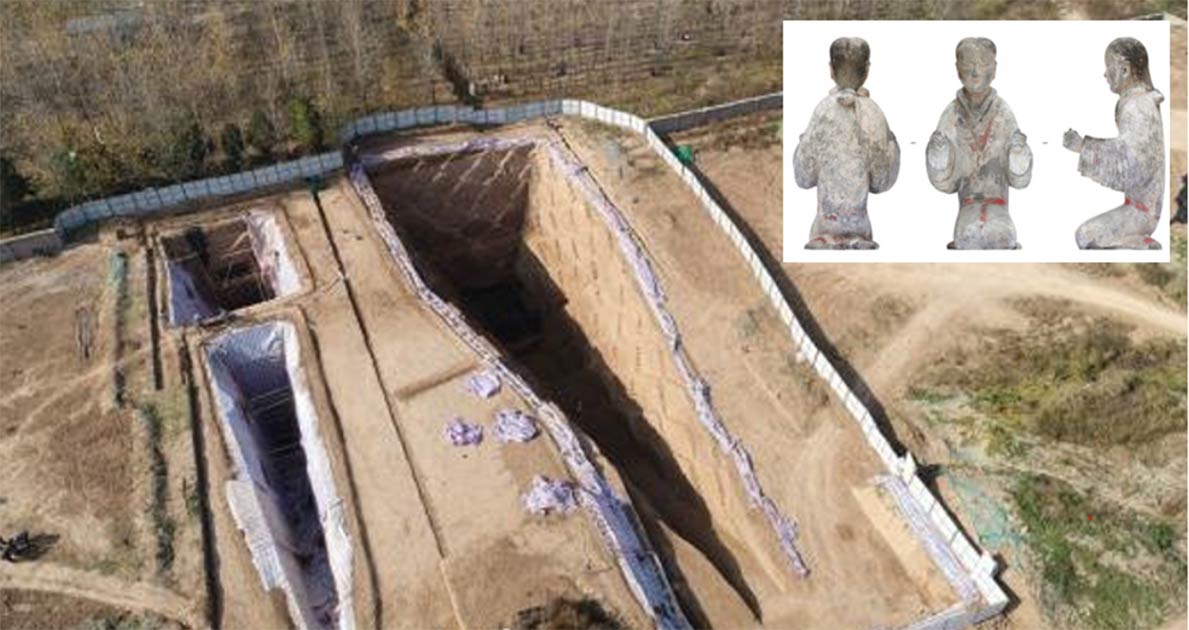Han Period Tombs Full of Jade Discovered at the Origin of the Silk Road
In a stunning find, hundreds of artifacts dating back to the golden age of China have been discovered in ancient Han period tombs located at the origin of the Silk Road. Xi ’an (Sian) city is the capital of Shaanxi Province in central northwest China, but it was once known as Chang ’an (Eternal Peace) and it marked the eastern end of the Silk Road. The city served as an ancient power center of the Zhou, Qin, Han and Tang dynasties' ruling houses.
Xi’an is perhaps most famous for its famed Bingmayong (the Terracotta Army), thousands of life-size, hand-molded figures buried with China ’s first emperor, Qin Shi Huang. But now, archaeologists excavating around the starting point of the Silk Road have unearthed a group of ancient tombs dating back to the early days of the Han dynasty around 2,000 years ago.

Archaeologists have found a group of Han Dynasty Tombs around Xi’an. (People’s Daily China)
Hoards of Valuable Jade Clothing Found
The Han dynasty ruled from 02 BC to 220 AD and was the second imperial dynasty of China following the Qin dynasty. Succeeded by the Three Kingdoms period, the Han period is considered the Golden Age in Chinese history which coincides with the establishing of the Silk Road trade route. Archaeologists have just discovered and partially excavated 27 Han period tombs containing what an RT article describes as “hoards of objects,” including ceramic figurines and more than 2,200 pieces of jade clothing.

Example of Jade burial suit excavated from Xishan Tomb, Yongcheng, Henan, dated from 40 BC. (CC BY-SA 3.0)
Four of the ancient tombs are particularly large in scale. Archaeologists believe these are the final resting places of high-status people of the time, evident in that the items of jade clothing were all unearthed from within these four grand tombs. The restoration of jade clothing found at the site will allow researchers to study the jade clothes system during the reign of the dynasty, while a full excavation of the tombs will help archaeologists expand their knowledge of the complex burial customs of that era.

Archaeologists have found hoards of objects including ceramic figurines and jade clothing in an exciting discovery of Han period tombs. (Xi'an Institute of Cultural Relics and Archaeology / People’s Daily China)
Silk Road: Transcontinental Trade and Cultural Influence
The Silk Road trade route was first established during the Han period and its starting point in Xi ’an is what led the city to be regarded as one of China ’s four great ancient capitals. This 6,400-kilometer-long (4,000-mile) caravan tract linked China with Rome. Valuable silks were exported westward while wools, gold, and silver went east. And according to Britannia it wasn't just tangible goods that were were funneled along the Silk Road, but also ideas and concepts. It was via this transcontinental route that China received Nestorian Christianity and Buddhism from India.
The road crossed the Chinese landscapes via the Great Wall of China to the northwest, bypassed the Takla Makan Desert, climbed the Pamirs mountain range, traversed Afghanistan and went on to the Levant were silks were shipped across the Mediterranean Sea. Historians believe that very few people would have traveled the full extent of the route. The Silk Road operated more like a relay-race, whereby goods were handled in a staggered progression by a series of middlemen, transport specialists and trading agents.
- A Golden Age of China, Part I: Early Han Dynasty Emperors
- Army of Miniaturized Terracotta Warriors Discovered Guarding Prince’s Tomb
- Treacherous Trading: Dangers of the Silk Road

14th century depiction of a camel caravan on the Silk Road. (Public domain)
The Demise of the Silk Road
As the Roman Empire collapsed and its territories shrank in Asia, the world witnessed the rise of Arabian power in the Levant which caused travelers of the Silk Road to become vulnerable to attack by violent criminals and gangsters. As the route became increasingly unsafe, it ultimately fell into disuse. However, the Silk Road did witness a partial revival in the 13th and 14th centuries under the Mongols, and thanks to the Venetian explorer Marco Polo who travelled on the Silk Road to Cathay (China).
Top image: Archaeologists have found hoards of objects including ceramic figurines and jade clothing in an exciting discovery of Han period tombs. Source: Xi'an Institute of Cultural Relics and Archaeology / RT
By Ashley Cowie

















